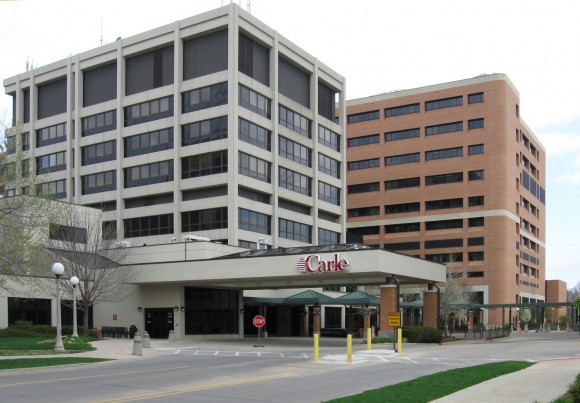People following me on Twitter often see me comment about my daily trips to the cancer center or hospital during the ten days following my rounds of chemotherapy treatment. I may tweet that I’m going to go get my granulocyte colonies stimulated, or I’m getting my GCS-F, or heading off to get my Neupogen. These all refer to the same injected medication.
On weekdays when I require one of these injections, I can get it at the lab in the cancer center. On the weekends, though, the cancer center is closed, so I go the the inpatient oncology ward at Carle Hospital.
It takes a little bit longer at the hospital, but I don’t mind. It’s the results of the injections that I’m interested in.
What does GCS-F do?
G-CSF [also known as colony-stimulating factor 3 (CSF 3)] is a colony-stimulating factor hormone. This hormone is produced naturally by the human body in order to stimulate the bone marrow to produce granulocytes and hematopoietic stem cells.
What Is a Hematopoietic Stem Cell?
A hematopoietic stem cell is a cell isolated from the blood or bone marrow that can renew itself, can differentiate to a variety of specialized cells, can mobilize out of the bone marrow into circulating blood, and can undergo programmed cell death, called apoptosis—a process by which cells that are detrimental or unneeded self-destruct.
A major thrust of basic HSC research since the 1960s has been identifying and characterizing these stem cells. Because HSCs look and behave in culture like ordinary white blood cells, this has been a difficult challenge and this makes them difficult to identify by morphology (size and shape). Even today, scientists must rely on cell surface proteins, which serve, only roughly, as markers of white blood cells.
Identifying and characterizing properties of HSCs began with studies in mice, which laid the groundwork for human studies. The challenge is formidable as about 1 in every 10,000 to 15,000 bone marrow cells is thought to be a stem cell. In the blood stream the proportion falls to 1 in 100,000 blood cells. To this end, scientists began to develop tests for proving the self-renewal and the plasticity of HSCs.
The “gold standard” for proving that a cell derived from mouse bone marrow is indeed an HSC is still based on the same proof described above and used in mice many years ago. That is, the cells are injected into a mouse that has received a dose of irradiation sufficient to kill its own blood-producing cells. If the mouse recovers and all types of blood cells reappear (bearing a genetic marker from the donor animal), the transplanted cells are deemed to have included stem cells.
5. Hematopoietic Stem Cells . In Stem Cell Information [World Wide Web site]. Bethesda, MD: National Institutes of Health, U.S. Department of Health and Human Services, 2011 [cited Sunday, April 17, 2011] Available at http://stemcells.nih.gov/info/scireport/chapter5
There are a couple reasons why this is important for me right now. The first reason is that all three of the drugs that I’m receiving during my current chemotherapy regimen, Ifosfamide, Carboplatin, and Etoposide, share a common side effect: low white blood cell count with increased risk of infection.
Neutrophils are one type of white blood cells. They usually make up between fifty and seventy percent of a person’s circulating white blood cells. They serve as the primary defense against infections by destroying bacteria in the blood. When the number of neutrophils in a person’s bloodstream drops below a certain level, that person is said to be suffering from neutropenia.
If a person’s neutrophil count falls below certain levels, even the bacteria normally present in our bodies could cause potentially life-threatening infections. Lowered counts can also result in a delay of scheduled chemotherapy. If counts aren’t above certain levels, it’s too dangerous to proceed until they bounce back. Luckily, injections of synthetic GCF-S, usually in the form of Neupogen (Filgrastim) or Neulasta (Pegfilgrastim), can help remedy that situation.
During my six months of ABVD regimen chemotherapy last year, I was twice delayed because of low neutrophil counts. After those delays, I began receiving injections of Pegfilgrastim following each chemotherapy session. It worked perfectly, and I wasn’t delayed or at extreme risk of infection during my remaining treatment.
My current situation is similar, but with a twist. I definitely want to try to minimize my risk to deadly infections. The twist is that I also happen to be preparing for an autologous hematopoietic stem cell transplant. Filgrastim is often used to prepare the blood for leukapheresis, in which hematopoietic stem cells are removed from the blood and then returned to the body following ablative chemotherapy.
Ablative chemotherapy will essentially destroy my bone marrow’s ability to produce white blood cells as it destroys the cancer cells. The return of my own stem cells will kick-start that blood cell production once again, returning me to good health.
Years of research into recombinant DNA and cloning have resulted in a synthetic version of a human hormone that can be used to save human lives. Research programs that I will take part in during my further treatment will help to extend and expand upon that research. That’s science, and that’s evidence that it’s an exciting time to be alive. I’ll try to keep everyone up to date here with my progress, as always.


3 comments
I wish you well.
Your explanation of GCS-F was very helpful. Thank you.
Author
Thanks, Eileen! I’m glad it helped out.
Science! It works, bitches.
Oh, and stop moving around. I keep having to update my RSS reader and blogroll. :p